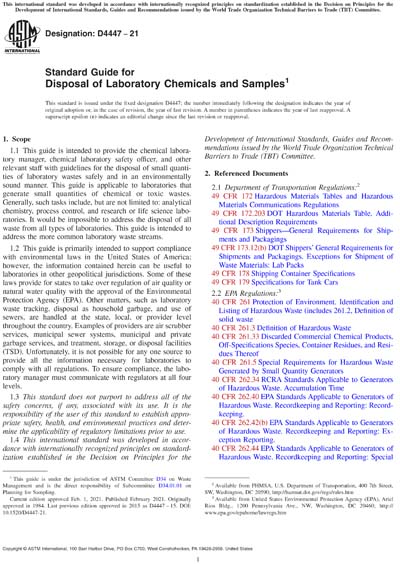Most recent
ASTM D4447-21
Standard Guide for Disposal of Laboratory Chemicals and Samples
1.1 This guide is intended to provide the chemical laboratory manager, chemical laboratory safety officer, and other relevant staff with guidelines for the disposal of small quantities of laboratory wastes safely and in an environmentally sound manner. This guide is applicable to laboratories that generate small quantities of chemical or toxic wastes. Generally, such tasks include, but are not limited to: analytical chemistry, process control, and research or life science laboratories. It would be impossible to address the disposal of all waste from all types of laboratories. This guide is intended to address the more common laboratory waste streams.
1.2 This guide is primarily intended to support compliance with environmental laws in the United States of America; however, the information contained herein can be useful to laboratories in other geopolitical jurisdictions. Some of these laws provide for states to take over regulation of air quality or natural water quality with the approval of the Environmental Protection Agency (EPA). Other matters, such as laboratory waste tracking, disposal as household garbage, and use of sewers, are handled at the state, local, or provider level throughout the country. Examples of providers are air scrubber services, municipal sewer systems, municipal and private garbage services, and treatment, storage, or disposal facilities (TSD). Unfortunately, it is not possible for any one source to provide all the information necessary for laboratories to comply with all regulations. To ensure compliance, the laboratory manager must communicate with regulators at all four levels.
1.3 This standard does not purport to address all of the safety concerns, if any, associated with its use. It is the responsibility of the user of this standard to establish appropriate safety, health, and environmental practices and determine the applicability of regulatory limitations prior to use.
1.4 This international standard was developed in accordance with internationally recognized principles on standardization established in the Decision on Principles for the Development of International Standards, Guides and Recommendations issued by the World Trade Organization Technical Barriers to Trade (TBT) Committee.
Content Provider
ASTM International [astm]






